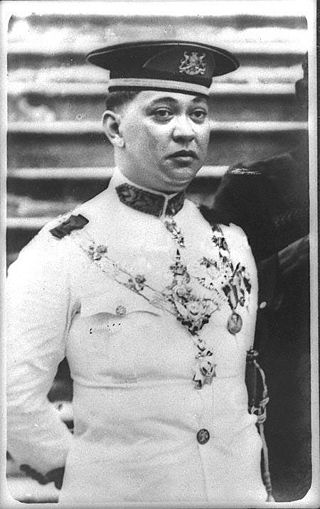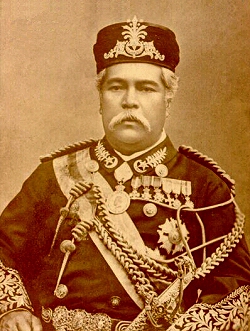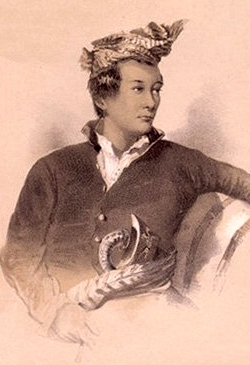
The Johore Strait is an international strait in Southeast Asia, between Singapore and Peninsular Malaysia.

Sultan Sir Ibrahim Al-Masyhur Ibni Almarhum Sultan Abu Bakar Al-Khalil Ibrahim Shah was a Malaysian sultan and the 22nd Sultan of Johor and the 2nd Sultan of modern Johor. He was considered to be "fabulously wealthy."

Sultan Ismail Al Khalidi Ibni Al-Marhum Sultan Sir Ibrahim Al-Masyhur was the 23rd Sultan of Johor and the 3rd Sultan of Modern Johor.

Sultan Sir Abu Bakar Al-Khalil Ibrahim Shah ibni Almarhum Temenggong Seri Maharaja Tun Daeng Ibrahim was the Temenggong of Johor. He was the 1st Sultan of Modern Johor, the 21st Sultan of Johor and the first Maharaja of Johor from the House of Temenggong. He was also informally known as "The Father of Modern Johor", as many historians accredited Johor's development in the 19th century to Abu Bakar's leadership. He initiated policies and provided aids to ethnic Chinese entrepreneurs to stimulate the development of the state's agricultural economy which was founded by Chinese migrants from Southern China in the 1840s. He also took charge of the development of Johor's infrastructure, administrative system, military and civil service, all of which were modelled closely along Western lines.

Pedra Branca is an outlying island and the easternmost point of Singapore. The name of the island refers to whitish guano deposited on the rock. The island consists of a small outcrop of granite rocks with an area of about 8,560 square metres (92,100 sq ft) at low tide. During the low water spring tide it measures, at its longest, 137 metres (449 ft) and has an average width of 60 metres (200 ft). Pedra Branca is situated at 1°19′48″N104°24′27″E, where the Singapore Strait meets the South China Sea.

The Johor Sultanate was founded by Malaccan Sultan Mahmud Shah's son, Sultan Alauddin Riayat Shah II in 1528. Johor was part of the Malaccan Sultanate before the Portuguese conquered Malacca's capital in 1511. At its height, the sultanate controlled modern-day Johor, Pahang, Terengganu, and territories stretching from the river Klang to the Linggi and Tanjung Tuan, Muar, Batu Pahat, Singapore, Pulau Tinggi and other islands off the east coast of the Malay peninsula, the Karimun islands, the islands of Bintan, Bulang, Lingga and Bunguran, and Bengkalis, Kampar and Siak in Sumatra. During the colonial era, the mainland part was administered by the British, and the insular part by the Dutch, thus breaking up the sultanate into Johor and Riau. In 1946, the British section became part of the Malayan Union. Two years later, it joined the Federation of Malaya and subsequently, the Federation of Malaysia in 1963. In 1949, the Dutch section became part of Indonesia.

The Johor–Singapore Causeway is a 1.056-kilometre (0.66 mi) causeway consisting of a combined railway and motorway bridge that links the city of Johor Bahru in Malaysia across the Straits of Johor to the district and town of Woodlands in Singapore. It was the only land connection between the two from 1928 until 1998, when the Tuas Second Link opened.

The term "British Malaya" loosely describes a set of states on the Malay Peninsula and the island of Singapore that were brought under British hegemony or control between the late 18th and the mid-20th century. Unlike the term "British India", which excludes the Indian princely states, British Malaya is often used to refer to the Federated and the Unfederated Malay States, which were British protectorates with their own local rulers, as well as the Straits Settlements, which were under the sovereignty and direct rule of the British Crown, after a period of control by the East India Company.

The Malaysia–Thailand border divides the countries of Malaysia and Thailand and consists of a land boundary running for 595 km (370 mi) across the Malay Peninsula and maritime boundaries in the Straits of Malacca and the Gulf of Thailand/South China Sea. The Golok River forms the easternmost 95 km stretch of the land border.

The Malaysia–Singapore border is an international maritime border between the Southeast Asian countries of Malaysia, which lies to the north of the border, and Singapore to the south. The boundary is formed by straight lines between maritime geographical coordinates running along or near the deepest channel of the Straits of Johor.

Sultan Sultan Ali Iskandar Shah I ibni almarhum Sultan Ahmad Hussein Muazzam Shah I was the 20th Sultan of Johor, who succeeded his father, Sultan Hussein after the latter died of natural cause in 1835. Over the next twenty years, Sultan Ali's claims to the office of Sultan of Johor were only recognised by some merchants and a few Malays. Like his father, Sultan Ali's was much of a puppet monarch and played a minimal role in the administrative affairs of the state, which came under the charge of the Temenggong and the British. In 1855, Sultan Ali ceded the sovereignty rights of Johor to Temenggong Daeng Ibrahim, in exchange for a formal recognition as the "Sultan of Johor" by the British and a monthly allowance. Following the secession of Johor, Sultan Ali was granted administrative charge over Muar until his death in 1877, and in most administrative matters, was often styled as the "Sultan of Muar".
Both Singapore and Malaysia have a conflict over water supplies ever since Singapore was separated from Malaysia in 1965.

The Indonesia–Malaysia border consists of a 1,881 km land border that divides the territory of Indonesia and Malaysia on the island of Borneo. It also includes maritime boundaries along the length of the Straits of Malacca, in the South China Sea and in the Celebes Sea.
The borders of Malaysia include land and maritime borders with Brunei, Indonesia and Thailand and shared maritime boundaries with Philippines, Singapore and Vietnam.

Pulau Merambong, formerly known as Pulo Ular, is an uninhabited island on the Straits of Johor. The island is dominated by mangrove swamp. It is located just 1 kilometre off the coast from Tuas, Singapore. Administratively, it is placed under the Pontian District, Johor, Malaysia.

Malaysia–Singapore relations refers to the bilateral relations between Malaysia and the Republic of Singapore, after the expulsion of Singapore from Malaysia in 1965. Singapore has a high commission in Kuala Lumpur and a consulate general in Johor Bahru, while Malaysia has a high commission in Singapore. Both countries are full members of the Commonwealth of Nations and ASEAN.
The Malaysia–Philippines border is a maritime boundary located in the South China, Sulu and Celebes Seas. It separates the Malaysian state of Sabah, which is on the island of Borneo, and the Sulu Islands of the southern Philippines.

Johor, also spelled as Johore, is a state of Malaysia in the south of the Malay Peninsula. Johor has land borders with the Malaysian states of Pahang to the north and Malacca and Negeri Sembilan to the northwest. Johor shares maritime borders with Singapore to the south and Indonesia to both the west and east. Johor Bahru is the capital city and the economic centre of the state, Kota Iskandar is the seat of the state government, and Muar serves as the royal capital of the state. Johor Lama served as the old state capital during the period of the Johor Sultanate. As of 2020, the state's population is 4.01 million, making it the second most populated state in Malaysia. Johor has highly diverse tropical rainforests and an equatorial climate. Situated at the southern foothills of the Tenasserim Hills, inselbergs and massifs dominate the state's flat landscape, with Mount Ledang being the highest point. Johor Bahru is one of the anchor cities of the Iskandar Malaysia development corridor, which is one of the most densely populated and fastest-growing urban areas in Malaysia.
The borders of Indonesia include land and maritime borders with Malaysia, Papua New Guinea, and East Timor, as well as shared maritime boundaries with Australia, India, Palau, Philippines, Singapore, Thailand, and Vietnam.















